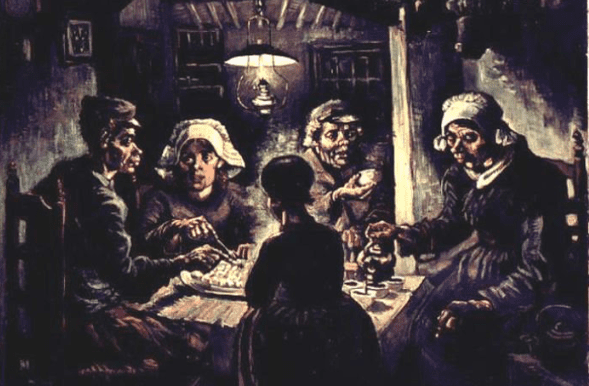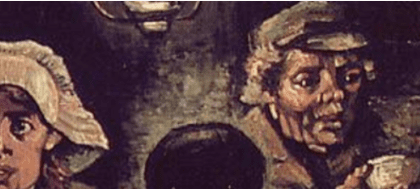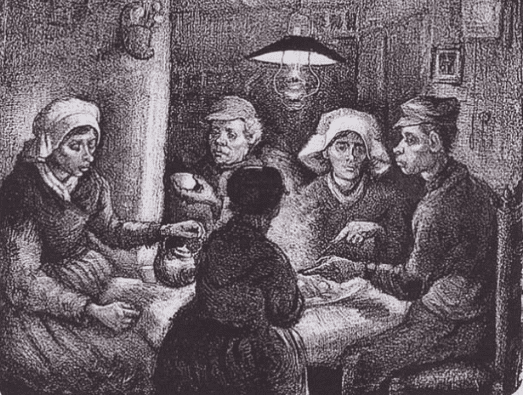Jeanne Dsouza
Manipal, India
One wants to be an honest man, one is so, one works as hard as a slave but still one cannot make both ends meet . . . One is afraid of making friends, one is afraid of moving, like one of the old lepers . . .
– Vincent Van Gogh, Autumn 18821

Van Gogh’s masterpiece, The Potato Eaters, has been admired for centuries, though art critics once decried its “dark colours and figures full of mistakes.” Van Gogh painted it in April of 1885 in his little lodge in the Netherlands, though the brushstrokes of his mind spanned across Norway, New York, England, and Japan. The lovers of Starry Sky, Irises, and Wheatfield with Crows may be inclined to pass over The Potato Eaters, so painful is its perplexing poignancy. In 1888, Van Gogh wrote, “Art is long and life is short, and we must wait while trying to sell our skin dearly.”2 Did the people portrayed in Van Gogh’s painting feel the same?
In 1859, Dutch physician Charles Landré wrote that “contagion” was the cause of leprosy transmission, a view contradicted by the “heredity as an ‘anti-contagion’ principle.”3 Leprosy had become a serious problem in Norway by the mid-nineteenth century.4 Census data in 1836, 1845, and 1852 reported increased incidence, and preventive measures were implemented following the 1852 census when more than 1700 cases were reported.5 Amidst all this debate, dilemma, and disease, as doctors struggled to study the transmission and treatment of leprosy, a young painter in his early thirties in the Netherlands was doing a different kind of study—that of hands and faces. He observed peasants and their lives, focusing on figures rather than landscapes.
Meanwhile, the leprosy bacillus was discovered by Gerhard Armauer Hansen in 1873.4 Isolating contagious persons was recommended to reduce its transmission. Until 1875, admissions to hospitals remained voluntary. By 1877 the rules had become more stringent. In 1885, patients with leprosy in Norway were isolated in their homes and their families separated from society.5 Police ensured that infected individuals were admitted to hospitals. The gloomy turbulence that swept across Norway stretched across the North Sea and onto the canvas of this artist in the Netherlands. The Potato Eaters depicts five worn-out individuals, half of them eating potatoes, the other half drinking coffee.

In the 1700s, herbalists had described potatoes as “weird products of dirt and darkness.”6 Tubers resembled a leper’s deformed limbs, and so myths arose that tubers caused leprosy. Cultivation and consumption of this staple food had been banned in Burgundy, in parts of Paris, and elsewhere. By Van Gogh’s time, though, the potato was once again food and friend, while the leper remained alien.
Van Gogh wanted to ennoble the lives of the peasants. “You see, I really have wanted to make it so that people get the idea that these folks, who are eating their potatoes by the light of their little lamp, have tilled the earth themselves with these hands they are putting in the dish,” he wrote.7 There is an air of misery in the picture (Figure 1), a sorrow borne by a united family that contrasts with the joy of eating the fruit of one’s labor.
The emaciated man with the oblong face has an irregularly shaped, elevated, erythematous plaque over the right cheek with two satellite eruptions. The small muscles of his right hand are wasted. The woman sitting beside him has a hypopigmented, hypoesthetic patch involving her philtrum. Her right eye appears wide open with a hazy cornea (exposure keratitis). There is muscle wasting and a claw deformity of her bony right hand.

The man holding a cup has hypopigmented, skin-colored, and erythematous nodules over his entire face, and a cord-like cutaneous nerve visible above the right eyebrow. His right hand appears nodular with muscle asthenia resulting in poor grip, as he gingerly holds a cup that is almost toppling over.
The woman with a kettle in hand has hypopigmented patches over her face and hands. A disfiguring nodule over her nose and a healing trophic ulcer with scar formation over the dorsum of her left middle finger are visible. The girl looks asymptomatic, but with time she too will receive the contagion, which is perhaps still in its incubation period.
At first, the observer may imagine it is the effect of light, but careful inspection reveals that light alone cannot create such alternating dark and light lesions. Holding a lens against the figures in the portrait brings out the features of the dreaded disease afflicting them (Figure 2). The dim light masks the complete manifestation of the condition. A further study of Van Gogh’s lithograph (Figure 3) confirms this: the lady with the kettle has a hypopigmented, postage stamp-shaped patch over her nose tip. There are ill-defined, hypopigmented areas over her chin and below her right lower eyelid. Atrophic, depressed, anesthetic patches over the dorsum of her right hand and irregular ulcers over the ulnar margin of the left hand are also seen. The man holding the cup has a collapsed nose tip and sagging skin of the left cheek. The lady near the lamp has a pointing left index finger, indicating an inability to flex it. All of them appear downcast.
Fellow artists criticized the disfigurement in this picture, some maintaining that Van Gogh knew little about the human face and proportions therein. Yet on closer inspection, it is the disfigurement that perfects this picture: a peasant family suffering from leprosy, growing and eating food far from society. The family likely remained self-sufficient, their condition guarded by its members until Van Gogh inadvertently stumbled upon it. The individuals felt themselves outsiders, but Van Gogh seemed to relate to them. There is a sense of impending doom in this picture; each individual experiences a closeness to the other and a closeness to death.
Whether Van Gogh ever surmised that the peasants he portrayed were lepers, whether these figures are from Netherlands or Norway, whether they sat in his line of vision or embodied his mental travels can only be conjectured. However, his letters indicate that the picture relies on memory: “Although I’ll have painted the actual painting in a relatively short time, and largely from memory, it’s taken a whole winter of studies of heads and hands.”1 His sharp observation and the genius of his mind captured the subtle intricacies of the disease manifestations. Notably, this painting was made at a time when “peasant paintings” were in vogue. Jozef Israëls and Jean-François Millet were quite famous for their paintings depicting hardworking and hearty peasant households, but there is a stark contrast between Van Gogh’s work and theirs.
With this painting, Van Gogh takes us into the sorrowful life of a stigmatized, shunned society. He knew them as poor, suffering peasants, perhaps oblivious to their chief privation, yet his artistic eye could not miss it. Van Gogh had felt at home with them, and made the spectators of his work feel at home with them as well.
References
- Vincent van Gogh. Letter to Theo van Gogh. WebExhibits Website. http://www.webexhibits.org/vangogh/letter/11/248.htm. Accessed July 04, 2021.
- Rare van Gogh letters offer insight into artist. Reuters website. https://www.reuters.com/article/us-vangogh. Published 2007. Accessed July 03, 2021.
- Menke HE, Wille RJ, Faber WR, et al. Bijdragen van Nederland en zijn koloniën aan de kennis over de oorzaak van lepra in de 19e eeuw [Contributions of the Netherlands and its colonies to the knowledge of the cause of leprosy in the 19th century]. Ned Tijdschr Geneeskd. 2007 Apr 7;151(14):825-30. Dutch. PMID: 17469325.
- Menke HE, Faber WR, Pieters T. Charles Louis Drognat Landré and Gerhard Henrik Armauer Hansen; contribution from a Dutch colony to the discovery of the leprosy bacterium. Lepr Rev. 2010 Mar;81(1):82-6. PMID: 20496573.
- Meima A, Irgens LM, van Oortmarssen GJ, et al. Disappearance of leprosy from Norway: an exploration of critical factors using an epidemiological modelling approach. Int J Epidemiol. 2002 Oct;31(5):991-1000. doi: 10.1093/ije/31.5.991. PMID: 12435774.
- The demoralizing esculent. Down to Earth Website. https://www.downtoearth.org.in /coverage/ economy / a great panic. Published 2009. Accessed July 05 2021.
- The Potato Eaters. Van Gogh Museum Website. https://www.vangoghmuseum.nl/en/collection/s0005V1962. Accessed July 2, 2021.
JEANNE MARIA DSOUZA is a medical student from Kasturba Medical College, Manipal, India. She is an avid writer and has published poems and prose in Indian newspapers and magazines. She has a tremendous interest in quizzing, and has stood first in many national level medical quiz competitions. She is passionate about art, literature, and medicine.
Highlighted in Frontispiece Volume 13, Issue 4 – Fall 2021 and Volume 13, Special Issue– Fall 2021

Leave a Reply